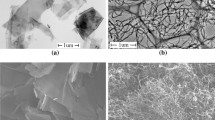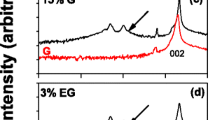Abstract
Polyvinylidene fluoride (PVDF)/polyacrilonitrile (PAN)/multiwalled carbon nanotubes functionalized COOH (MWCNTs-COOH) nanocomposites with different contents of MWCNTs were fabricated by using electrospinning and solution cast methods. The interaction of the MWCNTs with the polymer blend was confirmed by a Fourier transform infrared (FTIR) spectroscopy study. The dispersion of the MWCNTs in the polymer blend was studied by scanning electron microscopy. The dispersion of the MWCNTs in the polymer matrix at different compositions has been examined by using scanning electron microscopy (SEM). Both individual and agglomerations of MWCNTs were evident. Multiwalled carbon nanotubes are capable of enhancing the impedance and electrical conductivity of PVDF-PAN/MWCNTs in a wide frequency range at different temperatures. Nanocomposites based on PVDF/PAN and MWCNTs as fillers show a significant enhancement in the electrical conductivity as a function of temperature. In addition, PVDF/PAN with 5.58 wt.% of MWCNTs has a much higher specific energy (129.7Wh/kg) compared to that of PVDF/PAN (15.57 Wh/kg).The results reveal that PVDF/PAN/MWCNTs composites have potential applications for nanogenerators, organic semiconductors, transducers, and electrical energy storage.









Similar content being viewed by others
References
Stankovich S, Dikin DA, Dommett GH, Kohlhaas KM, Zimney EJ, Stach EA, Piner RD, Nguyen ST, Ruoff RS (2006) Graphene-based composite materials. Nature 442(7100):282–286
Wu M, Shaw L (2006) Electrical and mechanical behaviors of carbon nanotube-filled polymer blends. J Appl Polym Sci 99(2):477–488
Yuen SM, Ma CCM, Chiang CL, Lin YY, Teng CC (2007) Preparation and morphological, electrical, and mechanical properties of polyimide-grafted MWCNT/polyimide composite. J Polym Sci A Polym Chem 45(15):3349–3358
Aqeel SM, Küçükyavuz Z (2011) Characterization and electrical conductivity of poly (ethylene glycol)/polyacrylonitrile/multiwalled carbon nanotube composites. J Appl Polym Sci 119(1):142–147
Aqeel SM, Wang Z, Than L, Sreenivasulu G, Zeng X (2015) Poly (vinylidene fluoride)/poly (acrylonitrile)–based superior hydrophobic piezoelectric solid derived by aligned carbon nanotubes in electrospinning: fabrication, phase conversion and surface energy. RSC Adv 5(93):76383–76391
Wang Z, Colorad HA, Guo Z-H, Kim H, Park C-L, Hahn HT, Lee S-G, Lee K-H, Shang Y-Q (2012) Effective functionalization of carbon nanotubes for bisphenol F epoxy matrix composites. Mater Res 15(4):510–516
Agarwal A, Bakshi SR, Lahiri D (2016) Carbon nanotubes: reinforced metal matrix composites. CRC press
Wang Z, Lu M, Li H-L, Guo X-Y (2006) SWNTs–polystyrene composites preparations and electrical properties research. Mater Chem Phys 100(1):77–81
Zhang L, Zhang Q, Xie H, Guo J, Lyu H, Li Y, Sun Z, Wang H, Guo Z (2017) Electrospun titania nanofibers segregated by graphene oxide for improved visible light photocatalysis. Appl Catal B Environ 201:470–478
Wei H, Cui D, Ma J, Chu L, Zhao X, Song H, Liu H, Liu T, Wang N, Guo Z (2017) Energy conversion technologies towards self-powered electrochemical energy storage systems: the state of the art and perspectives. J Mater Chem A
Huang B, Wang Z, Chen L, Xue R, Wang F (1996) The mechanism of lithium ion transport in polyacrylonitrile-based polymer electrolytes. Solid State Ionics 91(3):279–284
Tatsuma T, Taguchi M, Iwaku M, Sotomura T, Oyama N (1999) Inhibition effects of polyacrylonitrile gel electrolytes on lithium dendrite formation. J Electroanal Chem 472(2):142–146
Nalwa HS (1995) Ferroelectric polymers: chemistry: physics, and applications. CRC Press, Boca Raton
Ducharme S, Reece TJ, Othon CM, Rannow RK (2005) Ferroelectric polymer Langmuir-Blodgett films for nonvolatile memory applications. IEEE Trans Device Mater Reliab 5(4):720–735
Naber RC, Asadi K, Blom PW, de Leeuw DM, de Boer B (2010) Organic nonvolatile memory devices based on ferroelectricity. Adv Mater 22(9):933–945
Guan F, Pan J, Wang J, Wang Q, Zhu L (2009) Crystal orientation effect on electric energy storage in poly (vinylidene fluoride-co-hexafluoropropylene) copolymers. Macromolecules 43(1):384–392
Guan F, Yuan Z, Shu EW, Zhu L (2009) Fast discharge speed in poly (vinylidene fluoride) graft copolymer dielectric films achieved by confined ferroelectricity. Appl Phys Lett 94(5):052907
Sreekumar TV, Liu T, Min BG, Guo H, Kumar S, Hauge RH, Smalley RE (2004) Polyacrylonitrile single-walled carbon nanotube composite fibers. Adv Mater 16(1):58–61
Ko F, Gogotsi Y, Ali A, Naguib N, Ye H, Yang G, Li C, Willis P (2003) Electrospinning of continuous carbon nanotube-filled nanofiber yarns. Adv Mater 15(14):1161–1165
Prilutsky S, Zussman E, Cohen Y (2010) Carbonization of electrospun poly (acrylonitrile) nanofibers containing multiwalled carbon nanotubes observed by transmission electron microscope with in situ heating. J Polym Sci B Polym Phys 48(20):2121–2128
Huang J, Cao Y, Huang Z, Imbraguglio SA, Wang Z, Peng X, Guo Z (2016) Comparatively Thermal and Crystalline Study of Poly (methyl-methacrylate)/Polyacrylonitrile Hybrids: Core–Shell Hollow Fibers, Porous Fibers, and Thin Films. Macromol Mater Eng 301(11):1327–1336
Guan X, Zheng G, Dai K, Liu C, Yan X, Shen C, Guo Z (2016) Carbon nanotubes-adsorbed electrospun PA66 nanofiber bundles with improved conductivity and robust flexibility. ACS Appl Mater Interfaces 8(22):14150–14159
Ghafari E, Feng Y, Liu Y, Ferguson I, Lu N (2017) Investigating process-structure relations of ZnO nanofiber via electrospinning method. Compos Part B 116:40–45
Heikkilä P, Harlin A (2008) Parameter study of electrospinning of polyamide-6. Eur Polym J 44(10):3067–3079
Huang Z-M, Zhang Y-Z, Kotaki M, Ramakrishna S (2003) A review on polymer nanofibers by electrospinning and their applications in nanocomposites. Compos Sci Technol 63(15):2223–2253
Varesano A, Carletto RA, Mazzuchetti G (2009) Experimental investigations on the multi-jet electrospinning process. J Mater Process Technol 209(11):5178–5185
Kim JS, Reneker DH (1999) Polybenzimidazole nanofiber produced by electrospinning. Polym Eng Sci 39(5):849–854
Fang X, Reneker D (1997) DNA fibers by electrospinning. J Macromol Sci Part B: Phys 36(2):169–173
Park SJ, Cho MS, Lim ST, Choi HJ, Jhon MS (2005) Electrorheology of multiwalled carbon nanotube/poly (methyl methacrylate) nanocomposites. Macromol Rapid Commun 26(19):1563–1566
Dong H, Nyame V, MacDiarmid AG, Jones WE (2004) Polyaniline/poly (methyl methacrylate) coaxial fibers: The fabrication and effects of the solution properties on the morphology of electrospun core fibers. J Polym Sci B Polym Phys 42(21):3934–3942
Gopalan AI, Santhosh P, Manesh KM, Nho JH, Kim SH, Hwang C-G, Lee K-P (2008) Development of electrospun PVdF–PAN membrane-based polymer electrolytes for lithium batteries. J Membr Sci 325(2):683–690
Yu H, Huang T, Lu M, Mao M, Zhang Q, Wang H (2013) Enhanced power output of an electrospun PVDF/MWCNTs-based nanogenerator by tuning its conductivity. Nanotechnology 24(40):405401
Sahoo NG, Bao H, Pan Y, Pal M, Kakran M, Cheng HKF, Li L, Tan LP (2011) Functionalized carbon nanomaterials as nanocarriers for loading and delivery of a poorly water-soluble anticancer drug: a comparative study. Chem Commun 47(18):5235–5237
Trchová M, Šeděnková I, Tobolková E, Stejskal J (2004) FTIR spectroscopic and conductivity study of the thermal degradation of polyaniline films. Polym Degrad Stab 86(1):179–185
Vasundhara K, Mandal BP, Tyagi AK (2015) Enhancement of dielectric permittivity and ferroelectricity of a modified cobalt nanoparticle and polyvinylidene fluoride based composite. RSC Adv 5(12):8591–8597
Song R, Yang D, He L (2007) Effect of surface modification of nanosilica on crystallization, thermal and mechanical properties of poly (vinylidene fluoride). J Mater Sci 42(20):8408–8417
He L, Sun J, Wang X, Yao L, Li J, Song R, Hao Y, He Y, Huang W (2011) Enhancement of β-crystalline phase of poly (vinylidene fluoride) in the presence of hyperbranched copolymer wrapped multiwalled carbon nanotubes. J Colloid Interface Sci 363(1):122–128
Bao S, Liang G, Tjong SC (2011) Effect of mechanical stretching on electrical conductivity and positive temperature coefficient characteristics of poly (vinylidene fluoride)/carbon nanofiber composites prepared by non-solvent precipitation. Carbon 49(5):1758–1768
Zhong G, Zhang L, Su R, Wang K, Fong H, Zhu L (2011) Understanding polymorphism formation in electrospun fibers of immiscible poly (vinylidene fluoride) blends. Polymer 52(10):2228–2237
Gao Q, Scheinbeim JI (2000) Dipolar intermolecular interactions, structural development, and electromechanical properties in ferroelectric polymer blends of nylon-11 and poly (vinylidene fluoride). Macromolecules 33(20):7564–7572
Almond D, West A (1987) The activation entropy for transport in ionic conductors. Solid State Ionics 23(1):27–35
Jonscher AK (1977) Theuniversal'dielectric response. Nature 267:673–679
Barik SK, Choudhary R, Singh A (2011) Ac impedance spectroscopy and conductivity studies of Ba0. 8Sr0. 2TiO3 ceramics. Adv Mater Lett 2(6):419–424
Kim D, Kim Y, Choi K, Grunlan JC, Yu C (2009) Improved thermoelectric behavior of nanotube-filled polymer composites with poly (3, 4-ethylenedioxythiophene) poly (styrenesulfonate). ACS Nano 4(1):513–523
Kang SD, Snyder GJ (2016) Charge-transport model for conducting polymers. Nat Mater 2: 252
Yu A, Itkis ME, Bekyarova E, Haddon RC (2006) Effect of single-walled carbon nanotube purity on the thermal conductivity of carbon nanotube-based composites. Appl Phys Lett 89(13):133102
Du J, Zhao L, Zeng Y, Zhang L, Li F, Liu P, Liu C (2011) Comparison of electrical properties between multi-walled carbon nanotube and graphene nanosheet/high density polyethylene composites with a segregated network structure. Carbon 49(4):1094–1100
Kovacs JZ, Velagala BS, Schulte K, Bauhofer W (2007) Two percolation thresholds in carbon nanotube epoxy composites. Compos Sci Technol 67(5):922–928
Carabineiro S, Pereira M, Nunes-Pereira J, Silva J, Caparrós C, Sencadas V, Lanceros-Méndez S (2012) The effect of nanotube surface oxidation on the electrical properties of multiwall carbon nanotube/poly (vinylidene fluoride) composites. J Mater Sci 47(23):8103–8111
Reddy ALM, Ramaprabhu S (2007) Nanocrystalline metal oxides dispersed multiwalled carbon nanotubes as supercapacitor electrodes. J Phys Chem C 111(21):7727–7734
Wang Q, Zhu L (2011) Polymer nanocomposites for electrical energy storage. J Polym Sci B Polym Phys 49(20):1421–1429
Acknowledgements
This publication was made possible by funding from the NIMHD-RCMI grant number 5G12MD007595 from the National Institute of Minority Health, Health Disparities and the NIGMS-BUILD grant number 8UL1GM118967 and National Science Foundation (Grant 1700429). This publication was also made possible by the Louisiana Cancer Research Consortium. The contents are solely the responsibility of the authors and do not necessarily represent the official views of the NIMHD. The authors also appreciate the support of Nanhu Scholars Program for Young Scholars of Xinyang Normal University.
Author information
Authors and Affiliations
Corresponding authors
Additional information
Salem M. Aqeel and Zhongyuan Huang contributed equally to this work.
Rights and permissions
About this article
Cite this article
Aqeel, S.M., Huang, Z., Walton, J. et al. Polyvinylidene fluoride (PVDF)/polyacrylonitrile (PAN)/carbon nanotube nanocomposites for energy storage and conversion. Adv Compos Hybrid Mater 1, 185–192 (2018). https://doi.org/10.1007/s42114-017-0002-5
Received:
Revised:
Accepted:
Published:
Issue Date:
DOI: https://doi.org/10.1007/s42114-017-0002-5




